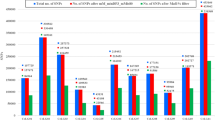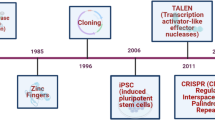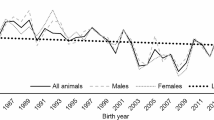Abstract
Identification of polymorphisms associated with economic traits is important for successful marker-assisted selection in cattle breeding. The family of mammalian sirtuin regulates many biological functions, such as life span extension and energy metabolism. SIRT2, a most abundant sirtuin in adipocytes, acts as a crucial regulator of adipogenic differentiation and plays a key role in controlling adipose tissue function and mass. Here we investigated single nucleotide polymorphisms (SNPs) of bovine SIRT2 in 1226 cattle from five breeds and further evaluated the effects of identified SNPs on economically important traits of Nanyang cattle. Our results revealed four novel SNPs in bovine SIRT2, one was located in intronic region and the other three were synonymous mutations. Linkage disequilibrium and haplotype analyses based on the identified SNPs showed obvious difference between crossbred breed and the other four beef breeds. Association analyses demonstrated that SNPs g.17333C > T and g.17578A > G have a significantly effect on 18-months-old body weight of Nanyang population. Animals with combined genotype TTGG at the above two loci exhibited especially higher body weight. Our data for the first time demonstrated that polymorphisms in bovine SIRT2 are associated with economic traits of Nanyang cattle, which will be helpful for future cattle selection practices.



Similar content being viewed by others
References
Grobet L et al (1998) Molecular definition of an allelic series of mutations disrupting the myostatin function and causing double-muscling in cattle. Mamm Genome 9(3):210–213
Grisart B et al (2002) Positional candidate cloning of a QTL in dairy cattle: identification of a missense mutation in the bovine DGAT1 gene with major effect on milk yield and composition. Genome Res 12(2):222–231
Cohen-Zinder M et al (2005) Identification of a missense mutation in the bovine ABCG2 gene with a major effect on the QTL on chromosome 6 affecting milk yield and composition in Holstein cattle. Genome Res 15(7):936–944
Howitz KT et al (2003) Small molecule activators of sirtuins extend Saccharomyces cerevisiae lifespan. Nature 425(6954):191–196
Frye RA (1999) Characterization of five human cDNAs with homology to the yeast SIR2 gene: Sir2-like proteins (sirtuins) metabolize NAD and may have protein ADP-ribosyltransferase activity. Biochem Biophys Res Commun 260(1):273–279
Imai S et al (2000) Transcriptional silencing and longevity protein Sir2 is an NAD-dependent histone deacetylase. Nature 403(6771):795–800
Guarente L (2006) Sirtuins as potential targets for metabolic syndrome. Nature 444(7121):868–874
Michan S, Sinclair D (2007) Sirtuins in mammals: insights into their biological function. Biochem J 404(1):1
Jing E, Gesta S, Kahn CR (2007) SIRT2 regulates adipocyte differentiation through FoxO1 acetylation/deacetylation. Cell Metab 6(2):105–114
Tong Q et al (2007) SIRT2 deacetylates FOXO3a in response to oxidative stress and caloric restriction. Aging Cell 6(4):505–514
Wang F, Tong Q (2009) SIRT2 suppresses adipocyte differentiation by deacetylating FOXO1 and enhancing FOXO1’s repressive interaction with PPARgamma. Mol Biol Cell 20(3):801–808
Krishnan J et al (2012) Dietary obesity-associated Hif1alpha activation in adipocytes restricts fatty acid oxidation and energy expenditure via suppression of the Sirt2-NAD + system. Genes Dev 26(3):259–270
Haketa A et al (2013) Association between SIRT2 gene polymorphism and height in healthy, elderly Japanese subjects. Transl Res 161(1):57–58
Sham P et al (2002) DNA pooling: a tool for large-scale association studies. Nat Rev Genet 3(11):862–871
Haliassos A et al (1989) Modification of enzymatically amplified DNA for the detection of point mutations. Nucleic Acids Res 17(9):3606
Ye S et al (2001) An efficient procedure for genotyping single nucleotide polymorphisms. Nucleic Acids Res 29(17):e88–e88
Falconer DS, Mackay TFC, Frankham R (1996) Introduction to quantitative genetics (4th edn). Trends Genet 12(7):280
Nei M, Roychoudhury A (1974) Sampling variances of heterozygosity and genetic distance. Genetics 76(2):379
Barrett JC et al (2005) Haploview: analysis and visualization of LD and haplotype maps. Bioinformatics 21(2):263–265
Li M et al (2013) SIRT1 gene polymorphisms are associated with growth traits in Nanyang cattle. Mol Cell Probes 27:215–220
Sun X-M et al (2013) Two novel intronic polymorphisms of bovine FGF21 gene are associated with body weight at 18 months in Chinese cattle. Livest Sci 155(1):23–29
Lefterova MI, Lazar MA (2009) New developments in adipogenesis. Trends Endocrinol Metab 20(3):107–114
Rosen ED, MacDougald OA (2006) Adipocyte differentiation from the inside out. Nat Rev Mol Cell Biol 7(12):885–896
Gesta S, Tseng YH, Kahn CR (2007) Developmental origin of fat: tracking obesity to its source. Cell 131(2):242–256
Nakae J et al (2003) The forkhead transcription factor Foxo1 regulates adipocyte differentiation. Dev Cell 4(1):119–129
Nawrocki AR, Scherer PE (2005) Keynote review: the adipocyte as a drug discovery target. Drug Discov Today 10(18):1219–1230
Khan IA et al (2006) In silico discrimination of single nucleotide polymorphisms and pathological mutations in human gene promoter regions by means of local DNA sequence context and regularity. In Silico Biol 6(1–2):23–34
Ron M, Weller JI (2007) From QTL to QTN identification in livestock–winning by points rather than knock-out: a review. Anim Genet 38(5):429–439
Sellner E et al (2007) Board-invited Review: applications of genomic information in livestock. J Anim Sci 85(12):3148–3158
Duan J et al (2003) Synonymous mutations in the human dopamine receptor D2 (DRD2) affect mRNA stability and synthesis of the receptor. Hum Mol Genet 12(3):205–216
Acknowledgments
This work was supported by the National 863 Program of China (Grant No. 2013AA102505), National Natural Science Foundation of China (No. 31272408), Program of National Beef Cattle Industrial Technology System (No. CARS-38) and Agricultural Science and Technology Innovation Projects of Shaanxi Province (No. 2012NKC01-13).
Author information
Authors and Affiliations
Corresponding author
Electronic supplementary material
Below is the link to the electronic supplementary material.
Rights and permissions
About this article
Cite this article
Sun, X., Li, M., Hao, D. et al. Two novel polymorphisms of bovine SIRT2 gene are associated with higher body weight in Nanyang cattle. Mol Biol Rep 42, 729–736 (2015). https://doi.org/10.1007/s11033-014-3821-2
Received:
Accepted:
Published:
Issue Date:
DOI: https://doi.org/10.1007/s11033-014-3821-2




